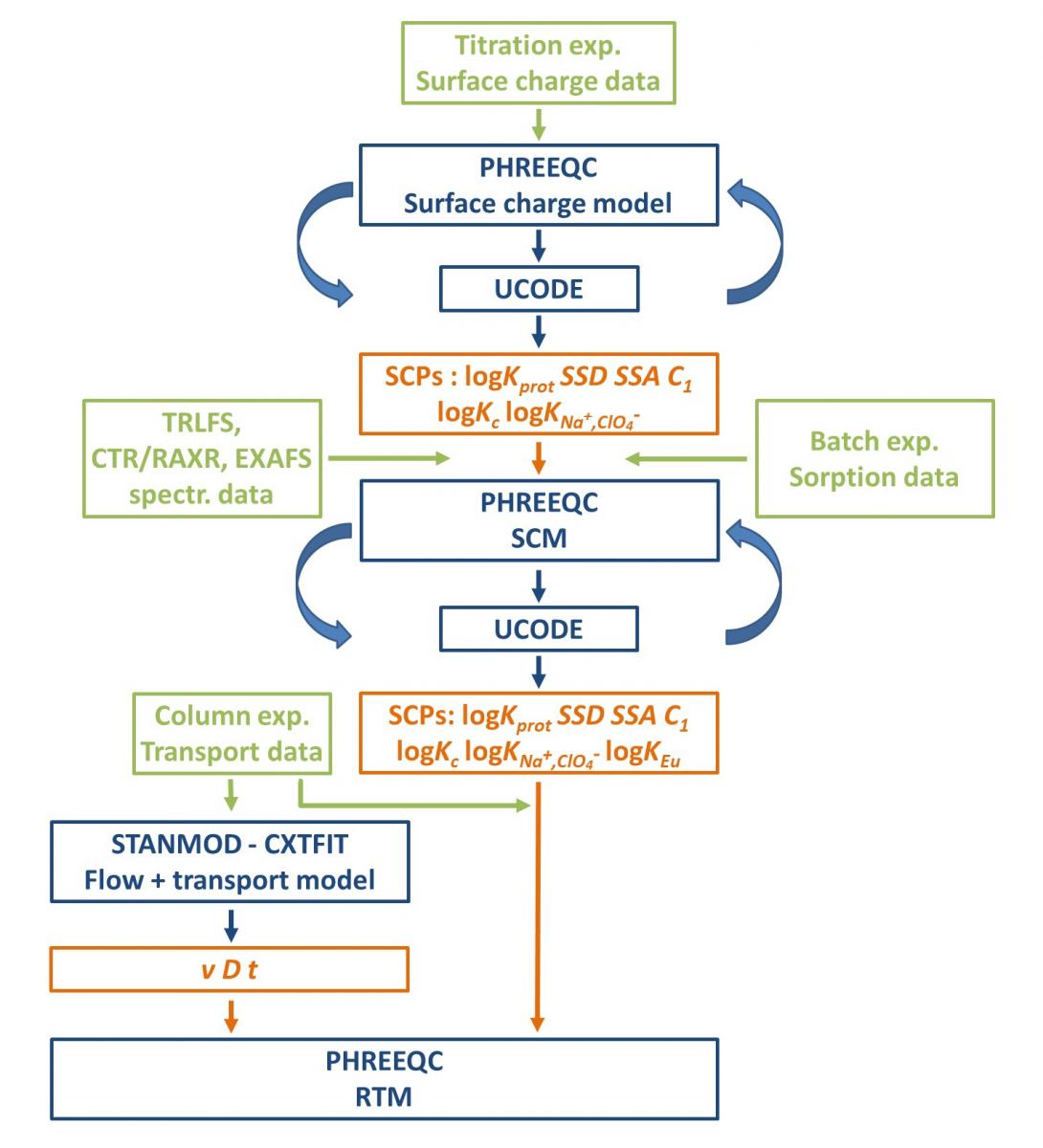Our experimental studies focus on retardation processes of mineral surfaces for a variety of long-term safety relvant elements. The studies aim to characterize transport and retardation processes via the determination of surface complexation parameters (SCPs) of natural, non-purified muscovite, orthoclase (K-feldspar), and quartz to subsequently simulate the reactive transport with mechanistic reactive transport models (PHREEQC, Parkhurst and Appelo, 2013). Therefore, a vast amount of experiments is carried out: Column titration experiments, batch sorption experiments, EXAFS and TRLFS measurements, and column transport experiments under artificial laboratory environments but also under complex, close to nature conditions. Amongst others, accompanying additional methods include SEM and XRD characterizations, HF digestions, and e.g. TC analyses.
To meachanistically describe surface complexation/retardation processes and reactive transport, surface charge and surface complexation models (PHREEQC; Parkhurst and Appelo, 2013) based on state-of-the-art TRLFS measurements are developed and verified (e.g. Neumann et al., 2020). It is the scope to determine mineral-specific SCP sets that are capable to reproduce sorption tendencies under varying geochemical conditions with the least amount of parameters to represent major retardation and transport trends. Thus, it was not the aim to precisely capture every detail for one geochemical condition but rather to be able to reproduce general immobilization tendencies.
Fig. 1: Flow chart of stepwise data evaluation procedure. Green boxes =
experimental data, blue boxes = modeling, orange = model parameters.
Therefore, a stepwise procedure is followed (cf. Fig. 1): Titration data is used to develop surface charge models to determine parameters relevant to describe surface charge properties. These parameters are used in surface complexation models which are based on spectroscopic data and batch sorption experiments. Finally, it is the aim to realistically simulate the reactive transport of long-term safety relevant elements.
Detailed information can be obtained from Neumann et al. (2020), Noseck et al. (2018), and Britz (2018), and Richter (2015).
References:
Neumann, J., Brinkmann, H., Britz, S., Lützenkirchen, J., Bok, F., Stockmann, M., Brendler, V., Stumpf, T., Schmidt, M., 2020: A comprehensive study of the sorption mechanism and thermodynamics of f-element sorption onto K-feldspar, J. Colloid Interface Sci. 2020. https://doi.org/10.1016/j.jcis.2020.11.041.
Noseck, U., Brendler, V., Britz, S., Stockmann, M., Fricke, J., Richter, C., Lampe, M., Gehrke, A., Flügge, J., (2018). Smart Kd-concept for long-term safety assessments – Extension towards more complex applications. Report GRS-500, BMWi-FKZ Nos. 02 E 11072A and 02 E 11072B. Gesellschaft für Anlagen- und Reaktorsicherheit (GRS) gGmbH, Braunschweig.https://www.grs.de/sites/default/files/pdf/grs-500.pdf
Britz, S.: Europium sorption experiments with muscovite, orthoclase, and quartz: Modeling of surface complexation and reactive transport, PhD thesis, DOI 10.24355/dbbs.084-201806051207-0, GRS Braunschweig, Theodor-Heuss-Sr. 4, Abt. 401, 38122 Braunschweig (2018).
Parkhurst, D. L., Appelo, C. A. J., 1999. User’s guide to PHREEQC (Version 2) - A computer program for speciation, batch-reaction, one-dimensional transport, and inverse geochemical calculations. U. S. Geological Survey, U. S. Department of the Interior.
Richter, C., (2015). Sorption of environmentally relevant radionuclides (U(VI), Np(V)) and lanthanides (Nd(III)) on feldspar and mica. Ph.D thesis, Technical University Dresden.
Contact: Julian Fricke, PD Dr. Moritz Schmidt, Dr. Johannes Lützenkirchen, Dr. Susan Britz
